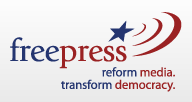Blog:
2012: What we know now on the value of volunteers, intentional conversation and collaboration for non-profit media

As the final of our four-part series exploring “Was 2012 the year of prosperity for publishers?” – in this post we explore the value of volunteers, intentional curated conversation and connected collaboration for non-profit media. We hear from Mark Glaser, executive editor of PBS MediaShift and Idea Lab; Dan Moulthrop, curator of conversation at The Civic Commons; and Josh Stearns, public media campaign director at Free Press. The third post in JA’s “what we know now” 2012 series offers specific ideas on building public trust, raising money and a free press powered by the people. The second post in the series reveals practical perspective on local advertising, meeting the needs of communities and customer connection. With 2013 now under way, may the lessons of 2012 help pave the way for greater prosperity in the year ahead!
Lean on Colleagues

Mark Glaser: “Sometimes if you ask colleagues for help, they say yes -- with almost no strings attached.”
Mark Glaser, Executive Editor, PBS MediaShift and Idea Lab
Here’s an important lesson I learned in 2012 about creating a sustainable news business. I run the MediaShift site for PBS, and our current funding comes from PBS, Knight Foundation, and sponsors for the site, events and newsletters. I have been doing more and more events, mixers and symposiums, which has been a good side business. When we recently had a Mixer in San Francisco, we asked attendees if they might volunteer to help us at the door with registration. We expected that some students might want to help. But instead we had volunteers who were pretty high-level colleagues. That was a surprise.
One of those was Terry Parris Jr. of Ustream. I asked him why he would want to volunteer and work the door at our Mixer. He said it would be fun and he really wanted to help out. We chatted a bit at the Mixer and struck up a conversation about ways we might work together. Eventually Terry wrote a piece for MediaShift about Ustream’s efforts around the election, and when I did a live-stream on Election Day, Ustream was a sponsor for that, providing equipment and support. Plus, Current TV offered to host the live-stream, and also offered up equipment and tech producing help.
My surprising lesson was that sometimes if you ask colleagues for help, they say yes — with almost no strings attached. As a small entrepreneur, the more such partnerships and collaborations you can find, the better your business can be sustainable.
In a Q&A with The Journalism Foundation in August 2012, Mark Glaser spoke about the history of MediaShift and the future democratization of the media.
“How do you think people will get their news in ten years / twenty years?”
“My guess is in more ways than they do even now, and from more sources too. What the Internet has been really good at is democratizing media, giving more people a voice, from bloggers to podcasters to Facebookers and beyond. My hope is that continues, spreads to more places around the world (as during the Arab Spring) and these new voices learn how to support themselves so they can be valuable to their communities. I’m especially hopeful that crowdfunding platforms (Kickstarter, Spot.us) and direct support can help journalists of all stripes continue to reach and serve local audiences.”
Chat, curate, connect
Dan Moulthrop, Curator of Conversation, The Civic Commons

Dan Moulthrop: “What if editorial boards began to function more like engagement boards?”
When we began The Civic Commons in 2010, we didn’t really know how the community might react. This year, a few things became clear.
Media companies are still just beginning to learn what engagement really means
When media execs talk about engagement, too many of them think about audiences engaging with their content, not the newspaper engaging with the community. What if editorial boards began to function more like engagement boards?
People love to live chat, especially when the conversation is curated
The curation metaphor gets thrown around a lot, but what we mean by it is that the conversation is intentional. We think about who would be most useful to hear from and what kinds of audiences should be invited. Why more news organizations aren’t doing stuff like this is beyond me.
Radio still works really well for explaining stuff
Last summer, we put our nascent podcast on ice for a bit, pending future fundraising. In the 60-some episodes produced, what was most helpful was breaking out of traditional forms. The best feedback we ever got? “That part where you were talking about selling tax credits – that was awesome!”
Even big, conservative institutions can do online engagement well
The biggest challenge is usually about giving the partners the impetus to own the engagement, rather than treat it like something someone else will take care of. The best example of this going really well is our project with Kent State University, where the Provost’s office and the Academic Affairs committee invited their community into six different dialogues to inform the 2013 Strategic Plan. This might sound boring, but hundreds of people were talking to one another and building on ideas raised.
Tools are maturing
No matter what your engagement need, there are great tools available for you.
Read more: http://theciviccommons.com/blog/five-things-we-learned-this-year
The Plain Dealer’s Grant Segall published a Q&A with Dan Moulthrop last year about The Civic Commons and curating conversations in Cleveland
“How do you curate conversation, anyway? Do you frame it and hang it on the wall?”
“Framing is useful. We curate public conversations to get just the right people to the table and have the right kind of conversation that has the potential to result in change or action.”
“So how’s that different from Facebook and our own cleveland.com and all the rest?”
“In five words: social media for civic good… Civic Commons was launched by the Fund for the Economic Future. The Knight Foundation is paying for it. We went online in late 2010.”
“We operate by seven principles: transparency, civility, credibility, participation, diversity, entrepreneurial spirit and optimism. We require names… If I want to start a conversation about something in my school district, I can invite everybody to join in, so we can find a common agenda: citizens and school board members and teachers and everyone who’s got a stake.”
A unified front
Josh Sterns, Journalism and Public Media Campaign Director, Free Press

Josh Stearns: “It's time to build a more connected and collaborative vision for non-profit media in America.”
The radically shifting landscape of media and technology has sparked a renaissance in non-profit and public media in the United States. As a perfect storm of economic and technological changes shakes the foundation of commercial media, journalists, funders, and local citizens are looking to public interest-oriented, mission-driven news organizations as a critical part of the solution. People who might never have considered a non-profit business model before — like longtime journalists and tech entrepreneurs — are launching vibrant, non-profit startups across the country.
Making the case for unity
A new report by Free Press argues, however, that despite all of this attention, non-profit media has yet to become greater than the sum of its parts. They serve different, albeit intersecting, audiences. Their membership and funding varies. They focus on different topics or geographies. Having a diverse media system is important, but too often these groups also define themselves through these differences. Surveying the different models, missions and approaches in the non-profit journalism sector makes it feel less like a unified whole, and more like a collection of parts.
The report, “Greater than the Sum,” argues that we need to begin constructing a new identity for non-profit journalism and media in America, one that illustrates the central role these institutions play in our nation. In addition, we must examine the media policies that have for too long served to divide non-profit media by platform instead of connecting them around purpose.
The changing face of non-commercial media
When most people think of non-profit and public media, they picture NPR and PBS. In reality, America’s non-commercial media sector has long encompassed more than just those national brands and is growing more diverse and multifaceted every year. To understand the whole picture, we have to view public media as a network of non-commercial and non-profit institutions that share a similar mission: serving diverse, local communities by providing alternatives and filling the notable gaps left by commercial media. It’s a diverse and innovative network of online and offline outlets, professionals and ordinary people, who are serving communities and re-envisioning public service media. …
As the non-commercial media sector grows in influence and importance, it’s time to build a more connected and collaborative vision for non-profit media in America.
Read more at: http://www.pbs.org/mediashift/2012/10/the-case-for-unity-among-non-profit-community-and-public-media277.html
The Global Minute’s David Patrick offered this insight about Josh Stearns and Free Press:
“What would a properly functioning news media actually look like? Picture it. Perhaps it’s a misguided question, or one with no real answer, but it still deserves to be asked. Most likely, or at least what everyone would most likely agree to, is a proper media would have a constant reflexivity to it, constantly surveying itself for mistakes to improve its transmission of information to citizens.”
“Imagine a skyscraper infinitely and indefinitely under construction, ever higher, ever better, but never quite finished; with laborers throughout endlessly coursing through its corridors and crawlspaces, correcting errors and crafting on what’s already been assembled.”
“Well, while the building certainly doesn’t exist, those workers do. Free Press just happens to be a collection of some of them. Free Press, a media reform and advocacy organization, works in Washington and from coast to coast promoting more diverse and independent ownership of media, sustainability for public media, effective investigative journalism, universal access to media platforms.”
With this as the final of the 2012 “what we know now” series, do you see ways these practical insights can fuel your success? What do you want to learn in 2013? What specific things are you excited to try?
















Weigh In: Remember to refresh often to see latest comments!
0 comments so far.